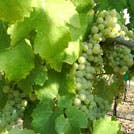
Viognier (pronounced 'vee-own-yay'), is a white grape varietal with a distinctly French background. With its own special charm, it has managed to squeeze in a seat at the red wine table; breezing into the room like a freshly groomed bachelor, leaving a pleasant scent in its wake.
Historically of Viognier
This particular full bodied white wine varietal retains a strong association with the Northern Rhône Valley in France; Condrieu to be more specific, where it is the only permitted white wine grape for this region. Although it's certainly no stranger to wine cellars and liquor stores today, it almost vanished completely in the mid 1960s. Jancis Robinson writes that when summarising for her '86 edition of 'Vines, Grapes & Wines' she tallied only 80 acres planted in the entire world. To date, there are plantings found in Australia, America, Italy, South Africa and Argentina. Yalumba, being Australia's leader of the pack. Not to the discredit of the grape family, but Viognier can be tough work for the discerning vintner. It is low yielding and very susceptible to powdery mildew. It benefits best from an environment in which the seasons are long and warm, but can also produce results in some cooler climates (think South Australia's Eden Valley). Having said this, Viognier has appeared as a somewhat important partnering in winemaking today.
Viognier: Cheat Sheet
| Viognier is a white wine grape, but often found blended with Syrah/Shiraz.. |
| Yalumba is Australia’s largest Viognier producer. |
| Viognier often displays aromas of peaches and cream. |
Viognier:It just seems to fit right in.
Viognier is a perfumed wine with low acidity, often delivering a fragrant display of peaches, apricots and cream. It is full bodied and can display properties similar to Chardonnay when oaked accordingly; though maintaining it's aromatic integrity, almost as if to be a social icebreaker between Chardonnay and Riesling at an important dinner date. With it's useful qualities, Viognier is often used in conjunction with red wine. In Australia, this produced some interesting results in early experimentation. Percentages were found in the mid-twenties and although delivering that faithful fragrant kick, it was not as subtle as we experience today. More like a custard tart served with a sausage; the savoury component was just too surprising. Currently, we see Viognier tastefully served up along the Aussie favourite Shiraz in much smaller doses, often around 5% (Being under 15%, the name is not required to appear on many a label). The awkward tart is no longer, with pancakes with maple and bacon taking its place. The result is a red wine, with full fruit flavour and a softening perfumed lift to the palate. If you haven't yet made friends with Viognier, now might be an appropriate time to introduce yourself...
